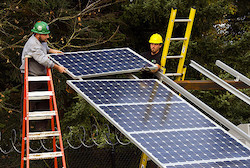SEJournal Online is the digital news magazine of the Society of Environmental Journalists. Learn more about SEJournal Online, including submission, subscription and advertising information.
TipSheet: After Trump Tariff, Local and Regional Stories Abound on Solar
While President Donald Trump’s solar panel tariff is grabbing national headlines, don’t let it distract you from the many local, state and regional stories about solar.
 The solar photovoltaic industry has been booming in the United States, growing 17 times faster than the U.S. economy as a whole. Solar was the largest source of new electric generating capacity in 2016, both worldwide and in the United States. Plus, solar jobs in the United States amount to more than 260,000.
The solar photovoltaic industry has been booming in the United States, growing 17 times faster than the U.S. economy as a whole. Solar was the largest source of new electric generating capacity in 2016, both worldwide and in the United States. Plus, solar jobs in the United States amount to more than 260,000.
The thing about solar jobs, though, is that in the United States there are far more jobs installing solar panels than in manufacturing them. According to the Bureau of Labor Statistics, solar installer is the fastest-growing U.S. job category. Or was, before the tariff.
The Trump tariffs are meant to protect two U.S. solar panel manufacturing companies (may require subscription), Suniva and SolarWorld, against dumping of cheap panels by foreign manufacturers like Malaysia and South Korea. But of the 260,000 solar jobs in the states, barely 2,000 are in panel manufacturing.
Right now, about 95 percent of the solar panels installed in the United States are imported from abroad. The 30 percent tariff just imposed by Trump will raise their price here, making solar more expensive in this country.
Higher prices will mean fewer installations — and a damper on solar job growth. The tariff may help the few U.S. panel manufacturers, but it will hurt installers.
Tariffs to have uneven regional impacts
The pain will not be felt evenly across the United States, which is where the local, state and regional stories come in.
First of all, there is more sunshine in Arizona than in Minnesota. You can see, from this Energy Department map, that the Southwest is blessed. So the potential for solar, whether utility-scale or residential rooftop, depends on where you live.
 |
| Oregon Department of Transportation workers install a solar panel in 2008. Photo: Oregon Department of Transportation |
Whether solar electricity flourishes in a given state depends a lot on the legal and regulatory conditions in that state. For rooftop solar to be economically feasible, the owner/operator of a panel needs to be able to sell the power (or excess power) to the electric utilities running the grid.
Some states have made this easy, with arrangements called “net metering” or “feed-in tariffs.” But some states have made it hard.
Also, in some locations, electric utilities have fought (may require subscription) to create an unfriendly environment for solar, especially rooftop solar. They see it as a threat (may require subscription) to their traditional business model that requires more customers and rising demand.
Much of the opposition comes from utilities that are heavily invested in coal, gas and nuclear fuels. They’ve brought the fight to state legislatures and public utility commissions, and often attack net metering, feed-in tariffs and tax incentives.
Battleground states have included Hawaii, Nevada, Arizona, Maine and Indiana.
Is there a battle in your state?
Solar manufacturing a multi-faceted story
If you are following the manufacturers of solar panels, there are a couple of things to keep in mind.
Where the company’s headquarters are, where the company’s panels are manufactured and where the company’s owners/stockholders are — these are three very different things.
Here is a breakdown of some relevant manufacturers. Another breakdown is here. And this one focuses just on panel manufacturers based in the United States.
By the way, neither of the two companies that brought on Trump’s solar tariffs are actually U.S.-owned. Some U.S. companies opposed the tariff because their panels are manufactured in Asia.
Most industry experts say President Trump’s claim that the solar tariff will create U.S. jobs is deceptive and inaccurate. The story of how the tariff affects jobs will be a local story, whether in Silicon Valley or the Midwest.
Reporting resources
Some good sources of information on solar include the Solar Energy Industries Association, or SEIA, the National Renewable Energy Laboratory, the American Council on Renewable Energy and the Solar Foundation.
The SEIA has an interactive map that breaks down the solar situation state by state. The group Solar Power Rocks has very useful breakdowns on state policy and other matters here and here.
Another state ranking comes from Al Gore’s Climate Reality Project. Solar Nation, which promotes residential rooftop installation, has a state breakdown here. One of the most complete state breakdowns comes from CleanTechnica.
* From the weekly news magazine SEJournal Online, Vol. 3, No. 5. Content from each new issue of SEJournal Online is available to the public via the SEJournal Online main page. Subscribe to the e-newsletter here. And see past issues of the SEJournal archived here.













 Advertisement
Advertisement 



